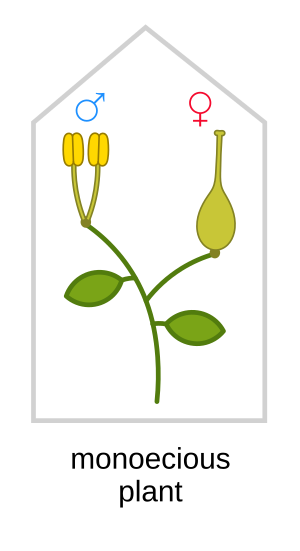
Back Enbo Danish تکپایه جنسی Persian Tumbuhan berumah satu ID 자웅동주 Korean Sambu NB Tek evcikli Turkish

Monoecy (/məˈniːsi/; adj. monoecious /məˈniːʃəs/)[1] is a sexual system in seed plants where separate male and female cones or flowers are present on the same plant.[2] It is a monomorphic sexual system comparable with gynomonoecy, andromonoecy and trimonoecy, and contrasted with dioecy where individual plants produce cones or flowers of only one sex and with bisexual or hermaphroditic plants in which male and female gametes are produced in the same flower.[3]
Monoecy often co-occurs with anemophily,[2] because it prevents self-pollination of individual flowers and reduces the probability of self-pollination between male and female flowers on the same plant.[4]: 32
Monoecy in angiosperms has been of interest for evolutionary biologists since Charles Darwin.[5]
- ^ "monoecious". Lexico UK English Dictionary. Oxford University Press. Archived from the original on September 5, 2021.
- ^ a b Batygina, T. B. (2019-04-23). Embryology of Flowering Plants: Terminology and Concepts, Vol. 3: Reproductive Systems. CRC Press. p. 43. ISBN 978-1-4398-4436-6.
- ^ Torices, Rubén; Méndez, Marcos; Gómez, José María (2011). "Where do monomorphic sexual systems fit in the evolution of dioecy? Insights from the largest family of angiosperms". New Phytologist. 190 (1): 234–248. doi:10.1111/j.1469-8137.2010.03609.x. ISSN 1469-8137. PMID 21219336.
- ^ Karasawa, Marines Marli Gniech (2015-11-23). Reproductive Diversity of Plants: An Evolutionary Perspective and Genetic Basis. Springer. ISBN 978-3-319-21254-8.
- ^ Nozaki, Hisayoshi; Mahakham, Wuttipong; Heman, Wirawan; Matsuzaki, Ryo; Kawachi, Masanobu (2020-07-02). "A new preferentially outcrossing monoicous species of Volvox sect. Volvox (Chlorophyta) from Thailand". PLOS ONE. 15 (7): e0235622. Bibcode:2020PLoSO..1535622N. doi:10.1371/journal.pone.0235622. ISSN 1932-6203. PMC 7332039. PMID 32614898.